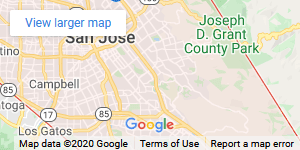A pool deck is essential for aesthetic appeal, safety, durability, and energy efficiency. Over time, wear and tear can manifest in signs that indicate it is necessary to consider resurfacing. Common issues such as cracks, fading, and uneven surfaces indicate that a refresh is needed.
Various resurfacing options, including concrete coatings and stamped concrete in San Jose, are available to assist in making informed decisions. Regular maintenance enhances the pool deck’s appearance and contributes to extending its lifespan and improving energy efficiency.
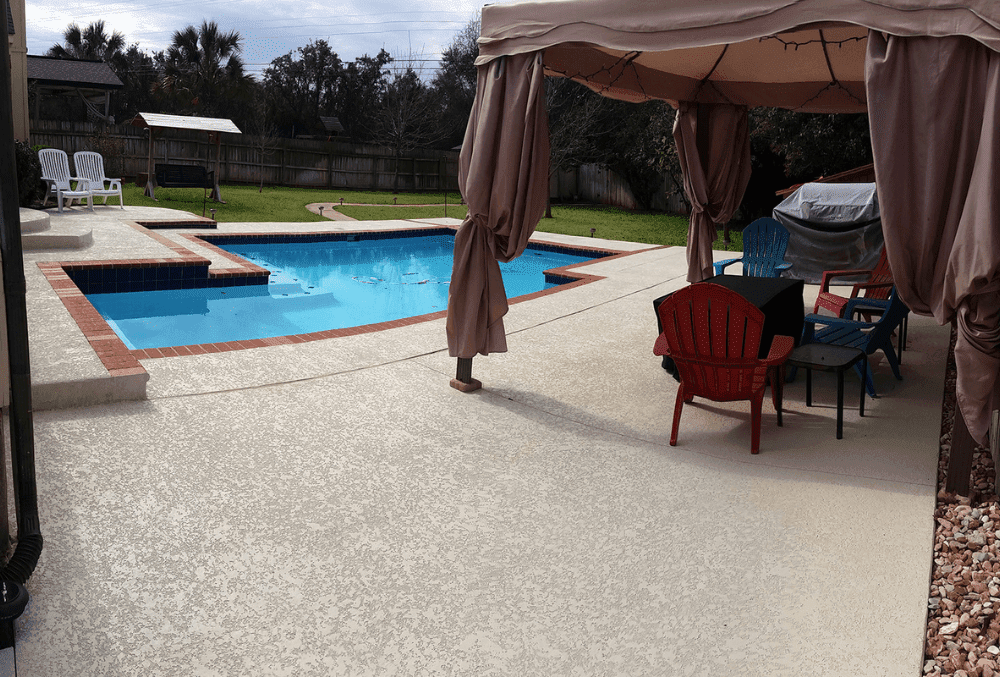
What is Resurfacing, and Why is it Important?
Resurfacing the pool deck is an essential maintenance activity that contributes to outdoor living spaces’ longevity and visual appeal, particularly in regions like San Jose where diverse weather conditions can affect concrete surfaces and pH level stability.
This process entails applying a new material layer, which enhances the pool deck’s aesthetic quality and functionality by improving safety, comfort, and energy efficiency for both family and guests.
Proper resurfacing can also rectify underlying issues such as cracks, discoloration, and general wear and tear, making it critical to evaluate the condition of the pool deck regularly.
Understanding the Lifespan of Pool Decks
Understanding the lifespan of pool decks is crucial for homeowners to make informed decisions regarding maintenance and resurfacing, including options such as knockdown texture San Jose.
Several factors must be considered, including the type of material utilized, environmental conditions, and maintenance practices.
The durability of a pool deck significantly impacts not only its aesthetic appeal but also the safety and comfort of individuals utilizing the swimming area.
In the San Jose area, homeowners may encounter options such as concrete and various resurfacing solutions, each offering distinct advantages and longevity.
Understanding these differences equips homeowners with the knowledge to invest in long-term outdoor improvements.
Signs that Indicate It's Time to Resurface Your Pool Deck
Recognizing the signs indicating it is time to resurface a pool deck is essential for maintaining safety and aesthetics. Various factors, including environmental exposure and wear, can lead to significant deterioration over time.
Homeowners in areas such as San Jose should be attentive to common indicators, including:
- cracks and chips
- fading and discoloration
- uneven or sinking sections
- stains that may compromise not only the visual appeal but also the functionality of their outdoor space.
Promptly addressing these issues through resurfacing can help homeowners avoid more extensive concrete repair costs.
Cracks and Chips
Cracks and chips in a pool deck indicate that resurfacing is necessary, as they detract from the overall appearance and can lead to further damage if left untreated.
Various types of cracks and chips may be encountered on pool decks. These can range from hairline fractures, often caused by natural settling, to larger chips resulting from heavy impacts or freeze-thaw cycles.
If overlooked, such damages do not merely compromise a property’s aesthetic appeal; they can also create hazards that affect safety, resulting in slips or trips.
As water infiltrates these cracks, it can lead to more extensive issues, such as undermining the integrity of the concrete.
Addressing these concerns promptly through resurfacing or specialized concrete repair services in San Jose is essential to maintaining safety in the area and protecting the investment in the property.
This proactive approach enhances the pool area’s visual aspects and extends the deck’s lifespan, making it imperative for property owners to take action without delay.
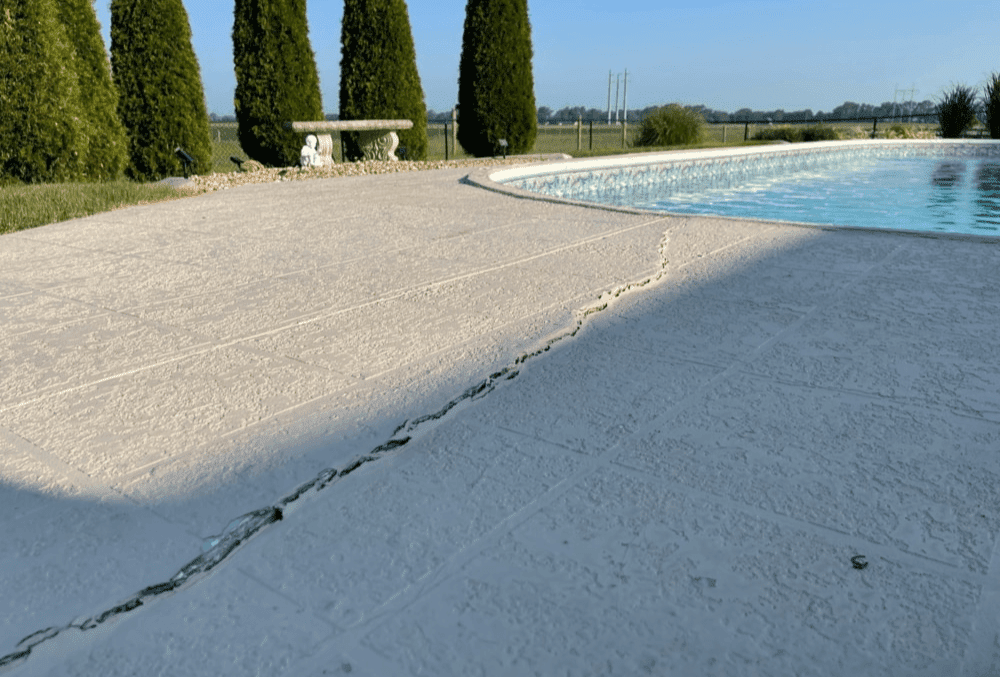
Fading and Discoloration
Fading and discoloration of a pool deck can significantly impact the aesthetics of outdoor space, indicating that resurfacing is necessary to restore its original appeal and protect the underlying concrete.
Over time, various factors can gradually degrade the surface, such as UV exposure, harsh weather conditions, and chemical imbalances in the pool water.
These elements not only cause color fading but may also contribute to the eventual cracking and chipping of the deck. It is crucial to address these issues promptly.
By resurfacing the pool deck, one can enhance the visual appeal of the outdoor area while simultaneously creating a protective layer that extends the lifespan of the concrete, particularly when using knockdown texture in San Jose.
- UV Rays: Prolonged exposure can lead to deterioration.
- Chemical Imbalances: Unbalanced water can adversely affect surfaces.
- Weather Fluctuations: Extreme temperatures can induce surface stress.
Selecting aesthetically pleasing concrete coatings can significantly improve the overall appearance. They offer attractive designs and long-lasting protection against fading and discoloration.
Uneven or Sinking Areas
Uneven or sinking areas on a pool deck can present significant safety hazards, making it essential to address these issues through resurfacing before they result in slips and falls.
When such irregularities arise, they increase the risk of accidents and can lead to water pooling, resulting in further complications and potential damage to the deck’s structural integrity.
Concrete repair solutions, including options available in San Jose, are critical in rectifying these problems.
They assist in restoring a level surface vital for safe navigation around the pool. Neglecting to address these issues may lead to costly repairs in the future and raise potential liability concerns.
By choosing resurfacing, property owners can effectively enhance the durability of their pool decks while ensuring a safer environment for all users.
Key benefits include:
- Improved overall safety
- Reduced risk of slips and falls
- Prevention of water pooling
- Enhanced aesthetic appeal
Stains and Mold Growth
Stains and mold growth on a pool deck are not only visually unappealing. Still, it may also indicate underlying issues that require resurfacing to maintain a clean and safe environment around the pool.
Plus aesthetic considerations, various stains, such as oil, rust, and algae, can present significant hazards.
Oil stains often originate from spilled sunscreen or cooking activities near the pool, while rust may result from metal furniture or pool accessories. Algae thrive in the warm, humid conditions characteristic of pool environments.
These factors contribute to the deterioration of the decking material and create slippery surfaces, thereby increasing the risk of accidents.
Regular maintenance is essential; pool owners can effectively prevent these issues by implementing effective cleaning protocols and understanding the conditions that promote mold growth.
- Establish a cleaning routine that includes checking for oil and organic residue weekly.
- Regular inspections should be conducted for signs of rust or mold accumulation.
- Consider resurfacing the deck every few years to ensure its durability.
Addressing these concerns promptly enhances the pool’s appearance and mitigates potential health risks associated with mold growth and slippery surfaces.
How to Choose the Right Resurfacing Option for Your Pool Deck
Selecting the appropriate resurfacing option for a pool deck necessitates a comprehensive understanding of the various materials and techniques available. Each option presents distinct benefits that cater to different needs and preferences.
This consideration is significant in a market such as San Jose, where climate conditions and usage patterns significantly influence the optimal choice for resurfacing.
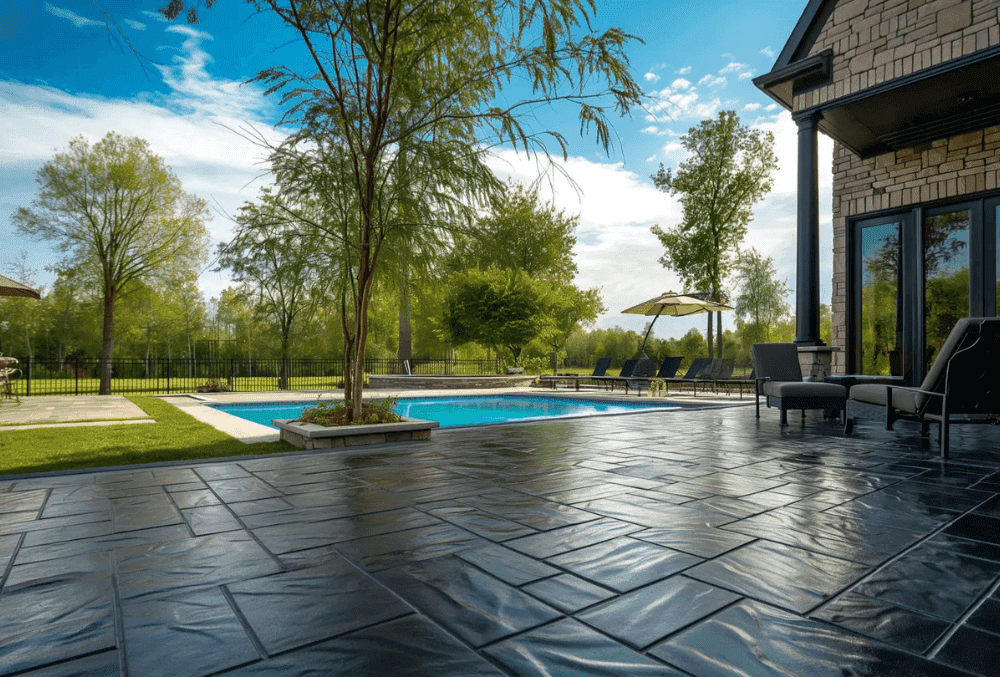
Concrete Coatings in San Jose
Concrete coatings in San Jose are increasingly recognized as an excellent option for pool deck resurfacing. They provide enhanced durability and aesthetic appeal while protecting against harsh weather conditions and pool chemicals.
These concrete coatings are available in various types, each presenting distinct advantages tailored to different requirements, including stamped concrete and knockdown texture options.
Employing these concrete coatings San Jose not only enhances the aesthetic of the pool area but also reinforces its durability, ensuring that it endures the test of time while improving safety by reducing slipperiness.
San Jose Pool Deck Resurfacing
San Jose pool deck resurfacing services are designed to address homeowners’ distinct climatic and aesthetic requirements, ensuring that the pool decking area remains safe, visually appealing, and functional throughout the year.
It is imperative to engage professionals who comprehensively understand these fluctuations in a region characterized by warm summers and intermittent rainy seasons.
Experts in local resurfacing are equipped to recommend materials and designs that can endure the elements, enhancing durability and appearance.
They thoroughly understand regional weather patterns, ensuring optimal surface adhesion and longevity. Local providers are also well-versed in state safety and environmental sustainability regulations, influencing the selection of resurfacing options.
By investing in local expertise, homeowners can enhance the visual appeal of their property and secure a resilient and reliable pool deck that prioritizes both leisure and safety.
Concrete Repair in San Jose
Concrete repair in San Jose is often a critical step before resurfacing, as addressing underlying issues such as cracks and chips is essential for achieving a smoother and more durable finish for the pool deck.
Ensuring that the surface is adequately repaired enhances the pool deck’s aesthetic appeal and mitigates further degradation caused by moisture infiltration and temperature fluctuations.
The importance of concrete repair San Jose cannot be overstated, as it establishes a solid foundation for a successful resurfacing project.
This comprehensive approach to concrete maintenance not only enhances the overall functionality of the pool deck but also extends its lifespan, ensuring that your investment is protected for years to come.
San Jose Stamped Concrete and pH Level Considerations
San Jose stamped concrete offers homeowners an attractive solution for pool deck resurfacing. It offers a variety of design options that effectively mimic natural materials while capitalizing on concrete’s durability.
This advanced technique enhances the aesthetics of outdoor environments and provides numerous choices that can accommodate any architectural style, from rustic to modern.
Homeowners can select from diverse patterns and colors, allowing them to create a unique appearance that harmonizes with their existing landscape.
Furthermore, the low maintenance requirements associated with stamped concrete render it a practical choice. This surface is less susceptible to cracks and stains, simplifying the cleaning process and upkeep compared to traditional materials.
Consequently, stamped concrete enhances visual appeal and ensures long-lasting performance.
Knockdown Texture in San Jose
Knockdown texture in San Jose is a highly effective resurfacing technique that enhances the visual appeal of pool decks while providing increased slip resistance, making it a practical choice for families.
This innovative approach transforms ordinary surfaces into visually striking areas, effectively combining style with functionality.
By employing a specialized application process, this method produces a unique, textured finish that is aesthetically pleasing and contributes to safety by significantly reducing the risk of slips and falls.
Opting for this resurfacing solution elevates the ambiance of the pool area and provides peace of mind for families with children and elderly individuals.
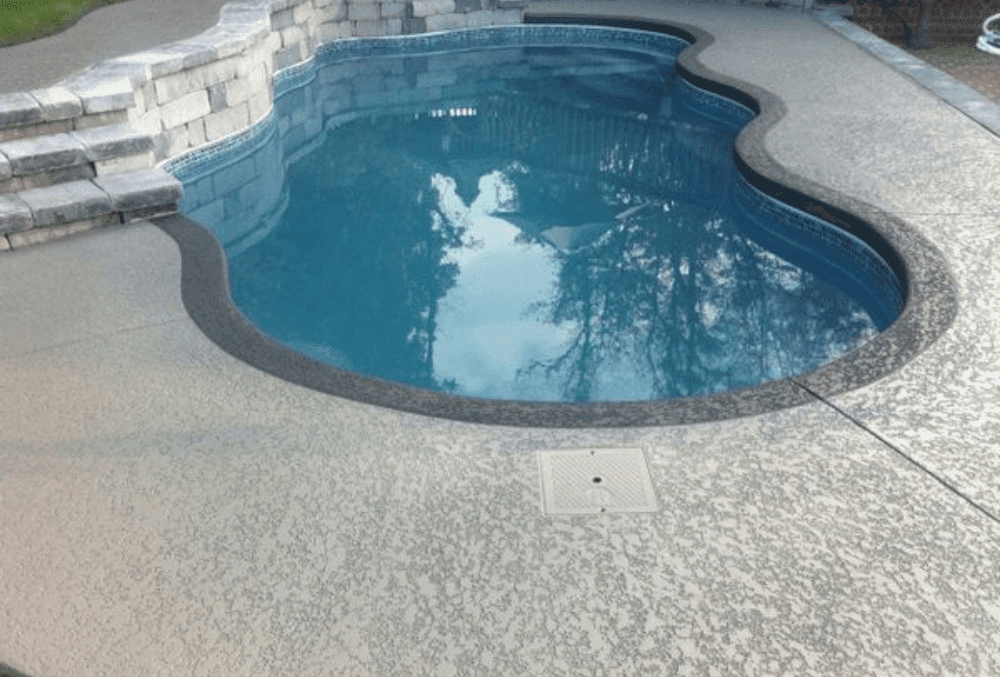
Factors that Affect the Lifespan of Your Pool Deck
Several factors influence the lifespan of a pool deck, including climate conditions, the quality of materials utilized, and the implementation of regular maintenance practices. Each of these elements plays a critical role in determining the durability and longevity of this investment.
Climate and Weather Conditions
Climate and weather conditions in a given region can significantly impact pool decks’ durability and maintenance requirements, making it imperative to consider local climatic factors when planning for resurfacing.
The interaction of various elements, such as humidity, precipitation, and temperature fluctuations, is critical in determining the longevity of outdoor surfaces.
For instance, elevated humidity levels can promote the growth of mold and mildew, resulting in the need for more frequent cleaning and treatment.
Likewise, heavy rainfall can lead to water pooling, which may compromise the integrity of materials if they are not designed for adequate drainage.
Furthermore, extreme fluctuations in temperature can cause materials to expand and contract, leading to potential cracking or warping.
- Elevated humidity can facilitate mold growth.
- Excessive rainfall can cause water pooling and structural damage.
- Temperature variations can harm materials, often resulting in physical damage.
Therefore, understanding these specific factors is essential for individuals seeking to effectively maintain or upgrade their pool deck.
Quality of Materials Used
The quality of materials utilized in constructing and resurfacing pool decks is critical for determining longevity and overall performance; therefore, careful selection is imperative.
Investing in high-quality materials can significantly enhance the aesthetic appeal of your outdoor space while concurrently minimizing future maintenance costs.
Selecting durable options ensures the deck can endure weather conditions and heavy foot traffic, preventing premature wear and tear.
A well-selected surface maintains its visual appeal and contributes to safer swimming experiences by offering improved slip resistance.
Factors such as durability, maintenance requirements, and visual impact must be considered when choosing materials for new installations and resurfacing projects.
Maintenance and Care
Regular maintenance and care are essential for extending the lifespan of a pool deck. Implementing straightforward practices can prevent significant issues over time, ensuring the outdoor space remains safe and visually appealing.
A consistent maintenance regimen that includes routine cleaning, inspection, and repair can significantly enhance the structure’s durability. Homeowners should consider the following actionable recommendations for effective pool deck maintenance:
- Regularly clean the surface to eliminate debris, dirt, and algae that can lead to deterioration.
- Conduct inspections for cracks or chips at least twice a year, addressing these issues promptly to prevent further damage.
- Seal the surfaces to create a protective layer that safeguards against moisture and minimizes wear.
- Apply non-slip treatments to enhance safety for all users, particularly children and elderly guests.
By incorporating these practices into their maintenance routines, homeowners can prolong the enjoyment of their pool decks while enhancing their outdoor spaces’ overall aesthetic appeal.
Importance of Regular Pool Deck Maintenance and Resurfacing
Regular maintenance and resurfacing of concrete pool decks are essential practices that ensure the longevity of the investment, enhance the safety of outdoor living spaces, and maintain aesthetic appeal, particularly in regions such as San Jose, where environmental factors can accelerate wear and tear.
Consistent maintenance protects the surface’s integrity and fosters a welcoming atmosphere for family and guests. w
Homeowners must recognize the significance of promptly addressing any signs of deterioration, as neglecting these issues can lead to more substantial problems, increased repair costs, and potential safety hazards.
Investing in professional pool deck resurfacing offers reassurance, keeping the area safe and visually attractive while extending its lifespan.
- Regularly evaluate the current condition of the pool deck.
- Stay informed about resurfacing options available.
- Consult with professionals for comprehensive assessments.
Assessing the condition of a pool deck is essential; therefore, property owners are encouraged to engage experienced contractors specializing in these services for tailored recommendations and solutions.
Frequently Asked Questions
Some common signs include cracks, chips, discoloration, and a rough or uneven surface. If you notice any of these issues, consider resurfacing your pool deck to maintain its lifespan.
The lifespan of your pool deck will vary depending on factors such as climate, usage, and maintenance. However, as a general rule, it’s recommended to resurface your pool deck every 5-7 years to keep it in good condition.
In some cases, minor repairs may be sufficient. However, if your pool deck has significant damage or multiple issues, it may be more cost-effective to resurface the entire deck to ensure a consistent and durable finish.
Resurfacing your pool deck can improve its appearance and increase its lifespan. It can also address any safety concerns, such as cracks or uneven surfaces, and make it more comfortable to walk on with features like a knockdown texture.
While some homeowners may choose to DIY their pool deck resurfacing, it’s a complex process that requires specialized tools and knowledge. For the best results and to avoid potential issues, it’s recommended to hire a professional concrete coatings company in San Jose.
Regular maintenance is key to extending the lifespan of your pool deck. This includes keeping it clean, monitoring the pH level to avoid damage, avoiding harsh chemicals, and addressing any issues as soon as they arise. Additionally, consider applying a sealant every 1-2 years to protect the surface and keep it looking like new.

